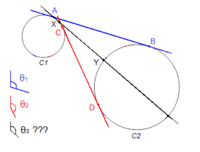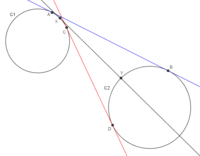
Hello,
I have two circles C1 and C2. The outer tangent from C1 to C2 is the blue line that touches points A and B. The inner tangent from C1 to C2 is the red line that touches points C and D. I already have these points calculated (and their subsequent angles) using the tangent theorem.
However, I do not know how to find the straight line that cuts right between the outer and inner tangents, as approximated by the black line XY. It appears to me that point Y should be midway between B and D, and it follows that point X should be midway between A and C, but I am not sure.
Can I get these points (and subsequent angle θ3) simply by knowing the inner and outer tangents? Any help would be much appreciated.


